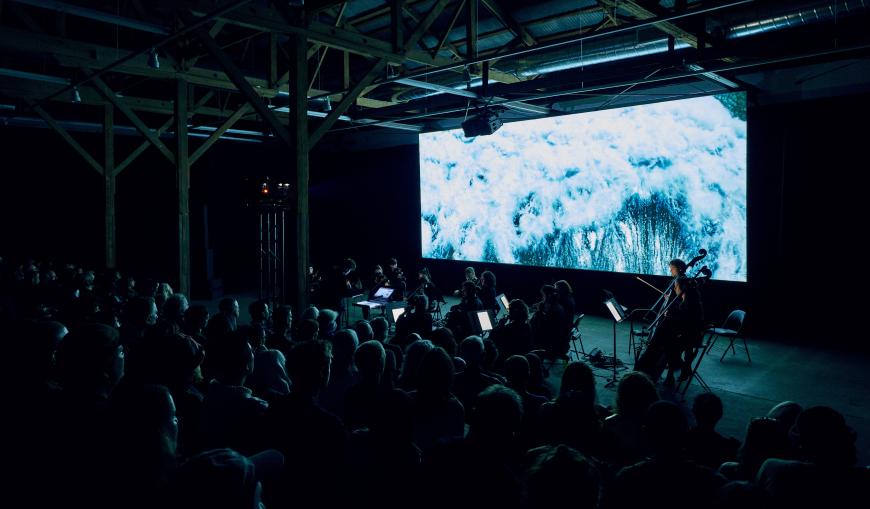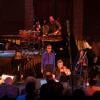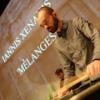
The Los Angeles art world is throwing its weight around nowadays. Another blue-chip gallery to arrive in town opened its doors this year. Curators are attracting big names and committing to broad scopes of inquiry, including musical/theatrical performance practices. This influx of highly lauded work comes with both glamor and pressure — will the hot new thing live up to the hype?
This is filmmaker Wu Tsang’s milieu. Her 2022 film Moby Dick; or, The Whale is a feature-length silent interpretation of Herman Melville’s epic with accompanying music composed by Caroline Shaw, Andrew Yee, and Asma Maroof. The film received its West Coast premiere last weekend at Hauser & Wirth’s Arts District space, co-presented by the gallery’s Performance Project and the Monday Evening Concerts (MEC) series. The movie also graced Stanford’s Bing Concert Hall on Nov. 8.

Tsang, Shaw, and Yee are no strangers to the zeitgeist. Tsang has been awarded a MacArthur “genius” grant and a Guggenheim Fellowship, lauded in the fashion world, and commissioned by many high-art institutions of note. Meanwhile, Shaw’s 2019 collaboration with the Attacca Quartet (Yee is the group’s cellist) won a Grammy.
But Saturday evening’s screening did not labor under the weight of lofty expectation. Instead, Tsang and her collaborators have created an engaging, delightfully uncanny, and mature work. The film draws equally on the dramatic traditions of silent film and the visual language of video installation to animate the central themes of Melville’s work — how white patriarchal systems of labor and capital marginalize the bodies that are subject to them. Taking place above and below the surface of the water, the movie explores the novel’s themes through a postcolonial lens.
Startling turns from a deeply emotive Tosh Basco (Queequeg) and wry narrator Fred Moten (credited as the Sub-Sub Librarian — Melville enthusiasts will understand) carry as much nuance as any lead performances in narrative cinema today. Josh Johnson’s choreography vivifies the physical interactions between the Pequod’s crew, from the tender to the violent.
Meanwhile, dusky, ruddy, and saturated lights transform human skin into a painterly array of blues and reds. Footage of whales and the water which threaten the sailors is, by contrast, almost sickeningly pale and bleak. Costumes from TELFAR x Kyle Luu blend the archaic and the contemporary into a single mythic register. The film creates a world that is purposefully, delightfully unreal.
The movie’s soundtrack is a fitting support for the emotional and aesthetic journey. Shaw’s modern-medieval idiom, full of diatonic chorales, ostinatos, and subtle, profound wrinkles, is the dominant musical language. Drones bloom into triadic harmonies before receding to a single point once more. Atop these features, roaming melodies help to carry the action of various scenes forward. In moments of greater drama, Shaw and Yee introduce keening glissandos and scratch tones to heighten the tension.
MEC’s in-house chamber ensemble ECHOI, here configured as a string orchestra, mastered the demands of Shaw and Yee’s score — the delicate, vibratoless blend and unyielding attention to slow-moving changes in texture. But the ensemble could have reached more often for a full-throated sound on Saturday, as the group did during the storm that followed Queequeg’s death. Too often, these dozen-plus musicians sounded like a string quintet.
ECHOI’s sound remained driven in the final chase scenes. Since the orchestra was mic’d in order to blend with prerecorded elements, it could have been bolstered by more aggressive placement in the mix to better marry with Maroof’s sonics — ambient and powerful, gluey sub-bass spiked with vocal interludes from Shaw and her trusty vocal harmonizer. Nevertheless, the combined din rang out powerfully. The post-chase silence — the evening’s first true grand pause — landed with equal impact in the gallery’s large, hangar-like screening space.
That large space lent the film’s contrasts — between sound and silence, human warmth and alien cold — additional heft. Tsang’s Moby Dick (like Melville’s) is a study of these contrasts at massive scale. And while the work would undoubtedly stand proudly in a traditional theater, Saturday evening’s staging seemed like the right space to plumb the film’s considerable depths.




